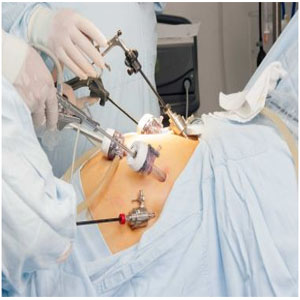What does minimally invasive surgery mean?
Minimally invasive surgery allows your surgeon to use techniques that limit the size and number of cuts, or incisions, that they need to make. It’s typically considered safer than open surgery. You’ll usually recover more quickly, spend less time in the hospital, and feel more comfortable while you heal.
In traditional open surgery, your surgeon makes one large cut to see the part of your body that they’re operating on. In minimally invasive surgery, your surgeon uses small tools, cameras, and lights that fit through several tiny cuts in your skin. This allows your surgeon to perform surgery without opening a lot of skin and muscle.

- Lap appendectomy: A laparoscopic (lap-a-ro- SKOPP-ik) or “lap” appendectomy is a minimally invasive surgery to remove the appendix through several small incisions, rather than through one large one.
- Lap cholecystectomy: A laparoscopic cholecystectomy is a surgery during which the doctor removes your gallbladder.
Diagnostic laparoscopy: Laparoscopy, also known as diagnostic laparoscopy, is a surgical diagnostic procedure used to examine the organs inside the abdomen.
- Lap omental and lymph node biopsy: An omental biopsy involves inserting a needle through the skin to take a sample of the omentum.
- Lap inguinal hernia repair {TEP}: Abstract: Laparoscopic totally extraperitoneal (TEP) inguinal hernia repair is an effective minimally invasive method for treating hernias that avoids entry into the abdomen
- Lap CBD exploration:: Common bile duct exploration is a procedure used to see if something like a stone is blocking the flow of bile from your liver and gallbladder to your intestine.
- Lap cardiomyotomy: cardiomyotomy (Heller’s operation) (kar-di-oh-my-ot-ŏmi) n. surgical splitting of the muscular ring at the junction of the stomach and oesophagus to relieve achalasia. A Dictionary of Nursing.
- Lap hysterectomy: A laparoscopic hysterectomy is a minimally invasive surgical procedure to remove the uterus. A small incision is made in the belly button and a tiny camera is inserted.
- Lap ovarian cystectomy: An ovarian cystectomy is surgery to remove a cyst from your ovary.
- Lap colectomy: Laparoscopic colectomy, also called minimally invasive colectomy, involves several small incisions in your abdomen.
A pigtail drain is one (1) type of drain, used to let fluid out of the area around the lungs or abdominal organs. A doctor called a radiologist puts in this drain if your child needs it. They numb the area where the drain goes, so the procedure usually does not hurt.
Types of Minimally Invasive Surgery
Robotic surgery
Advanced robotic systems give doctors greater control and vision during surgery, allowing them to perform safe, less invasive, and precise surgical procedures.
During robotic-assisted surgery, surgeons operate from a console equipped with two master controllers that maneuver four robotic arms. By viewing a high-definition 3-D image on the console, the surgeon is able to see the surgical procedure better than ever before. Computer software takes the place of actual hand movements and can make movements very precise.
The benefits of minimally invasive robotic surgery can include:
- Less scarring
- Quick recovery time
- Short hospital stay
- Low risk of infection
- Less pain
- Small incisions
- Reduced blood loss
Not all minimally invasive procedures are completed with robot assistance, and not all medical cases are right for robotic-assisted surgery—some patients may benefit from endoscopic or open (traditional) surgery.
Non-robotic minimally invasive surgery (endoscopic)
Non-robotic minimally invasive surgery is also known as endoscopic surgery. You also may be familiar with terms like laparoscopic surgery, thoracoscopic surgery, or “keyhole” surgery. These are minimally invasive procedures that utilize an endoscope to reach internal organs through very small incisions.
During endoscopic surgery the surgeon inserts a thin, flexible tube with a video camera through a small incision or a natural orifice like the mouth or nostrils. The tube has a channel to utilize tiny surgical instruments, which the surgeon uses while viewing the organs on a computer monitor.
This technique allows the surgeon to see inside the patient’s body and operate through a much smaller incision than would otherwise be required of traditional open surgery.
The benefits of endoscopic surgical procedures can include:
- Small incisions, few incisions, or no incision
- Less pain
- Low risk of infection
- Short hospital stay
- Quick recovery time
- Less scarring
- Reduced blood loss
